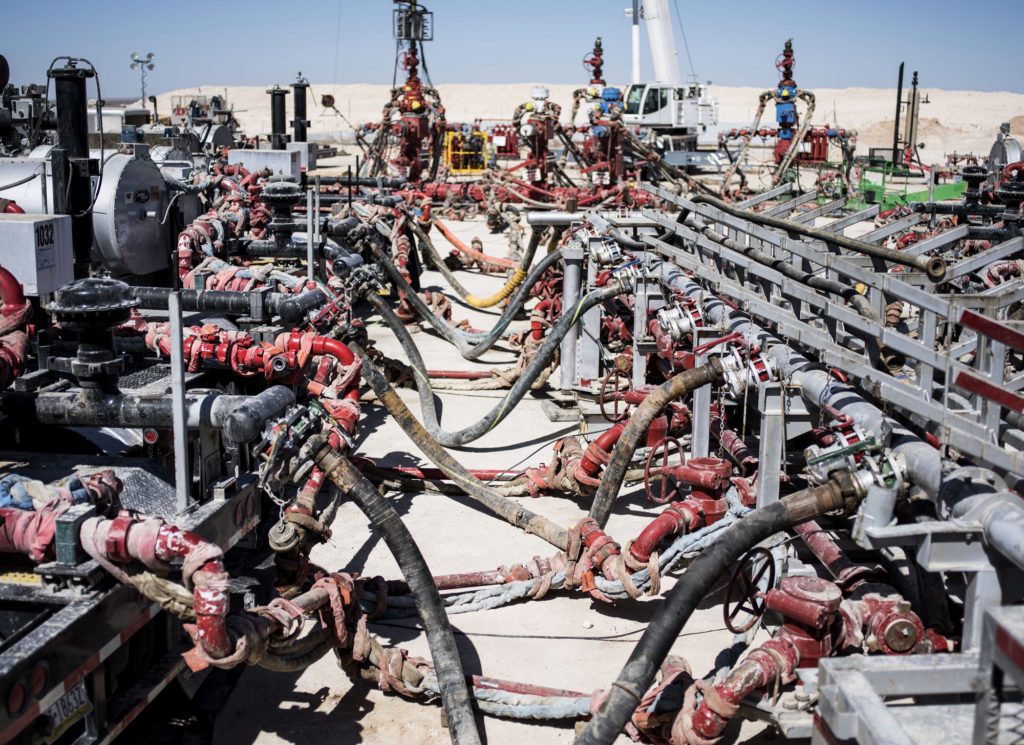
The oil prospectors of Oklahoma, it appeared, finally had a solution to their earthquake problem.
Ordered by regulators to curb the wastewater they were dumping deep into the ground, they watched with satisfaction as tremors plunged to fewer than two a day from more than five. This seemed to be important confirmation of what had long been suspected in the petroleum-dependent state: The act of drilling for crude wasn’t the big problem, it was just the way the main byproduct was being discarded.
But now quakes are popping up in a relatively new corner of Oklahoma’s shale patch and sparking jitters once again. It’s not the volume (so few that officials are just starting to record them) or force (very low on the Richter Scale) that’s worrisome. It’s the circumstances — because in the Scoop and Stack, the fields where the earth is suddenly moving, almost no wastewater is jettisoned underground.
That, in turn, has brought critical attention back to fracking, the essential technology that has made the oil business viable in countless low-margin fields, helping push output so high the U.S. recently hit 10 million barrels a day for the first time in four decades.
Oklahoma lawmakers and regulators aren’t inclined to put heavy brakes on the use of a tool that has helped triple output in the past decade to 497,000 barrels a day and create thousands of jobs. After all, the state, the fifth-largest producer in the U.S., was among the first to forbid cities and counties from banning fracking activities.
To some industry defenders in Oklahoma, in fact, low-level tremors now and again are a fair price to pay. In any event, the ones out in the Scoop and Stack are so minor experts are still puzzling over their significance.
But “all earthquakes start out small,” said Austin Holland, a supervisory geophysicist with the U.S. Geological Survey in New Mexico who worked for the Oklahoma Geological Survey until 2015. “You can’t rule out the possibility that you could have a significant earthquake triggered by hydraulic fracturing.”
That’s what the state wants to avoid. Wastewater disposal has already set off some sizable quakes, including a 5.7 magnitude in 2011 that shattered windows, crumbled masonry, closed a school and spurred at least one lawsuit.
It was in 2009 that the Sooner State, territory once highly unfamiliar with earthquakes, suddenly began to be really rattled by them — just as oil output, and fracking, started to zoom. By 2014, Oklahoma was more seismically active than California. Other shale-rich regions in North America have experienced a rise in quakes as crude production has gone up.
Seismologists and geologists concluded the main reason by far was the reinjection into disposal wells of water that gushes up with oil and gas. These blasts can stir fault lines that had been quiet for centuries.
Limiting the quantity that could be shot back into Earth and slowing the speed at which it was discharged made a difference: Earthquakes of at least 2.7 magnitude dropped to a daily average of just 1.7 last year from a high of 5.4 in 2015, according to the Oklahoma Corporation Commission, which regulates the industry.
Then, late in 2016, the tiny tremors began to be felt around the Scoop and Stack, shale plays in the Anadarko Basin. Central Oklahoma “started seeing some relatively small earthquakes,” said Jeremy Boak, director of the Oklahoma Geological Survey, “and some slightly up-in-arms residents.”
And now the quakes “are rising to a number to where you can count them,” said Matt Skinner, a spokesman for the commission.
The investigation into the new mini-quake epidemic has only recently begun. “We were preoccupied with the other earthquakes,” Boak said. “We’re just coming back” to the frack-quake risk and figuring out what to do about it.
Fracking opponents have seized on the issue. They have long viewed the process as environmentally risky, and several governments agree: New York, Vermont, Maryland, Ireland and France are among those that have banned it. Last week, New Jersey Governor Phil Murphy said he would join his counterparts in Delaware, New York and Pennsylvania to support a prohibition in the Delaware River Basin.
There’s no question that hydraulic fracturing, to use the technical term, is hard-hitting. Water, sand and chemicals are blown down a well under extremely high pressure to crack tightly-packed shale. The force can cause tiny subterranean trembles.
In Oklahoma, only about 4 percent of fracking jobs result in quakes that can be felt above ground. While research is still underway across the U.S. and Canada as to what’s behind the frack-quake phenomenon, seismologists suspect a ready-to-slip fault line must be nearby for hydraulic fracturing to cause a tremor that registers.
“At the end of the day, what we need to do is make sure we’re limiting the felt activity,” said Chad Warmington, head of the state Oil & Gas Association. “That kind of takes care of everything.”
Oklahoma requires drillers to stop fracking for at least six hours after an earthquake of 3.0 in magnitude. If one registers 3.5 or more, they must suspend operations for two days and coordinate with regulators on plans for restarting.
That, according to frack critics, isn’t enough.
“I am incredibly concerned about where we are in Oklahoma,” said Johnson Bridgwater, director of the local Sierra Club. “They’re just fracking like crazy.” Without a slowdown, “we’re setting the state up for some large mass-magnitude earthquakes.”